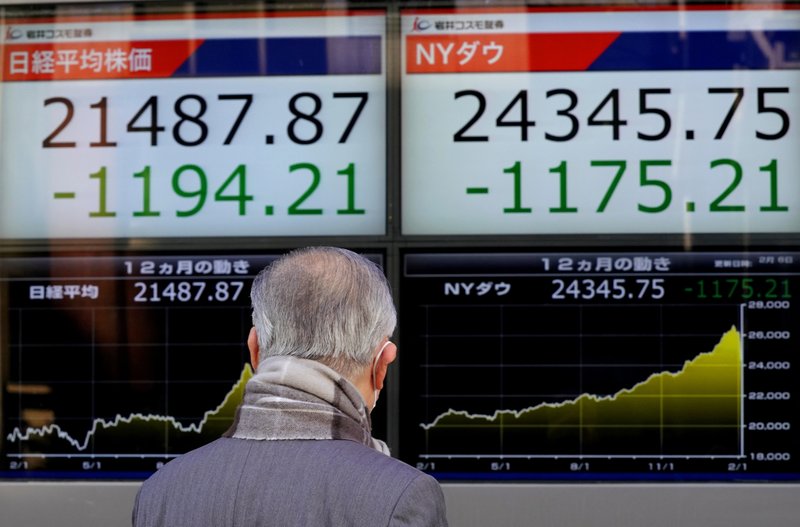NEW YORK (AP) — U.S. stocks are reversing course Tuesday morning after sharp losses in the first few minutes of trading, raising hopes of a halt to a global sell-off in the stock market.
The early gains follow the market's steepest drop in six and a half years. Major indexes in Asia and Europe tumbled following Monday's 1,150 point drop in the Dow Jones industrial average. Investors remain fearful that signs of rising inflation and higher interest rates could bring an end to the bull market and the economic recovery that has boosted stocks in recent years.
Trading was choppy in the early going Tuesday, likely to be one of the most watched days on the markets in years. The Dow Jones industrial average fell 567 points at the open but roared back and was up 146 points, or 0.6 percent, to 24,491 at 10:00 a.m. The Standard & Poor's 500 index rose 31 points, or 1.2 percent, to 2,680 after a 4.1 percent drop Monday.
The Nasdaq composite added 84 points, or 1.2 percent, to 7,052. The Russell 2000 index of smaller-company stocks gave up 5 points, or 0.3 percent, to 1,485.
Big dividend companies including utility and real estate companies fell, as bond yields increased after a sharp drop on Monday. Technology and industrial companies and retailers moved higher, a possible sign of confidence the U.S. economy will keep growing.
The market mood turned decidedly fearful on Monday when the Dow Jones industrial average posted its biggest percentage decline since August 2011, driven by fears the U.S. Federal Reserve will raise interest rates faster than expected due to a pick-up in wages. Those stemmed from the U.S. jobs report on Friday.
That has fed into widespread concerns that markets were stretched following a strong run over the past year that pushed many indexes to record highs. Some also question the possible role of computer-driven algorithmic trading in the precipitous declines or even the ramifications of the rise and fall in the value of virtual currencies, notably bitcoin.
"If investors look at underlying earnings growth and the fundamentals of the global economy, there is reason for optimism," said Neil Wilson, senior market analyst at ETX Capital.
"However once this kind of stampede starts it's hard to stop."
Among the biggest losers Tuesday was Tokyo's Nikkei 225 stock average, which ended 4.7 percent lower. Hong Kong's Hang Seng skidded 5.1 percent and South Korea's Kospi declined 1.5 percent.
In Europe, the British FTSE 100 index fell 2.4 percent while the CAC 40 in France fell 2.8 percent and Germany's DAX was down 2.7 percent.
Though many stock indexes are close to where they started the year, the losses mark a reversal of fortune following a sustained period of gains, a pullback that some market pros have been predicting for some time.
Stephen Schwarzman, the chairman and CEO of financial firm Blackstone, warned recently of a potential "reckoning" in markets.
A 10 percent drop from a peak is often referred to as a "correction" while a bear market is generally defined as a 20 percent or so drop in indexes. The S&P 500, for example, is one of the major fallers, was down 7.8 percent since its latest record high on Jan. 26 as of Monday's close.
"Seemingly the only hope for the markets at the moment is that investors suddenly decide that the sell-off has been a bit overdone," said Connor Campbell, a financial analyst at Spreadex.
Despite the sea of red in global stock markets, there are hopes that the retreat won't last long given that global economic growth has picked up and the financial system is more robust since the financial crisis.
"That is not to say that we won't see further falls in coming days, but in an environment where growth is good and earnings are expected to rise globally, there are decent underpinnings," said James Knightley, chief international economist at ING.
On Monday, the Dow finished down 4.6 percent while the S&P 500 sank 4.1 percent, to 2,648.94. The last fall of that size came in August 2011 when investors were fretting over Europe's debt crisis and the debt ceiling impasse in Washington that prompted a U.S. credit rating downgrade.
Still, while some financial assets became more attractive to investors as perceived havens of value. Gold, for example, was up 0.4 percent at $1,343 an ounce.
The U.S. dollar remained resilient despite the stock market sell-off, which at one stage Monday saw the Dow shed 1,597 points. The euro was up 0.3 percent at $1.2435 while the dollar rose 0.3 percent to 109.38 yen.
